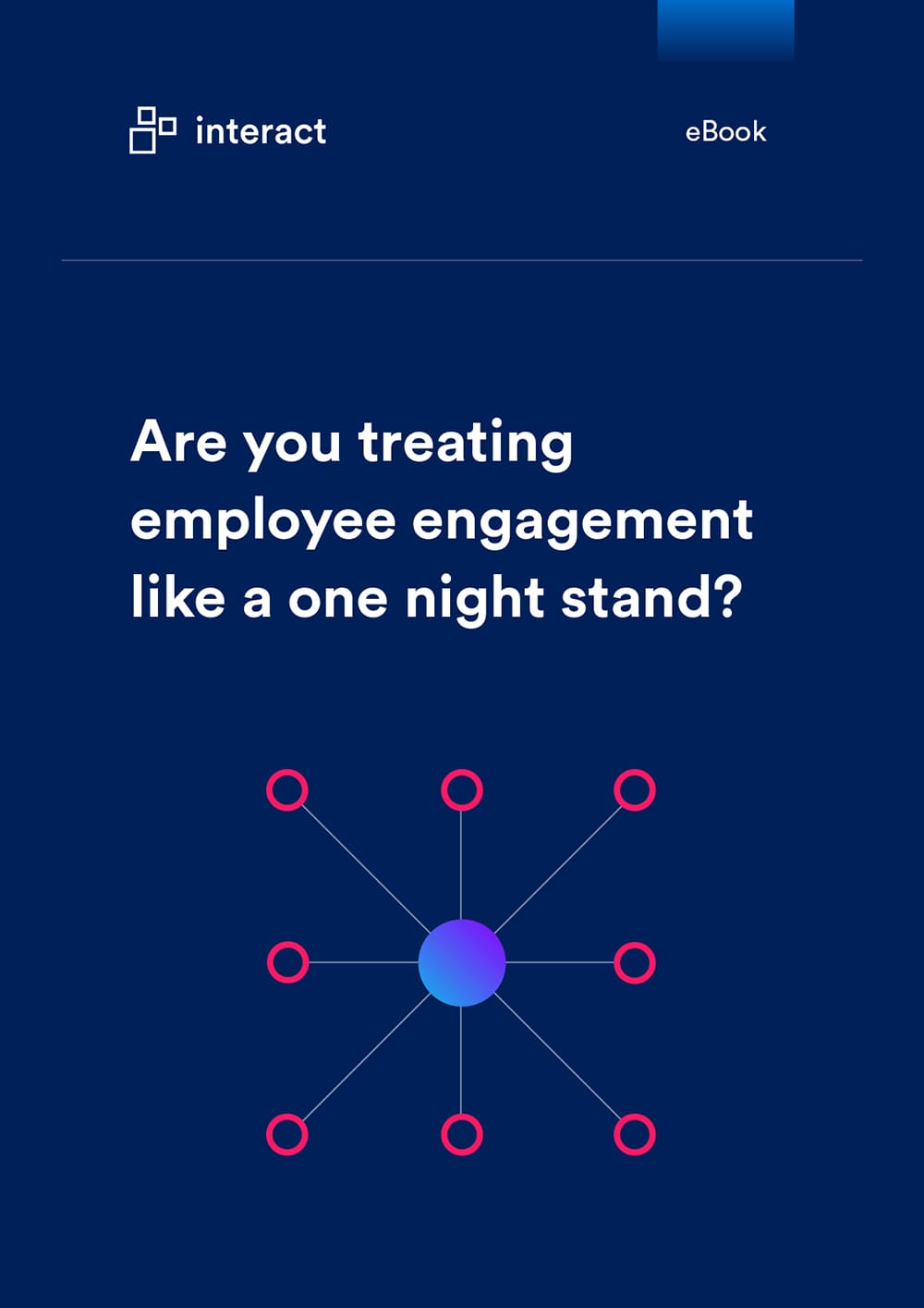The research that drove Gallup to write their original report on the State of the American Workplace was conducted nearly ten years ago. That’s the report that says only about 30% of workers in the U.S. are engaged and that engagement costs companies between $450 and $550 billion each year. If you’re in communications or HR, even if you’re just interested in the corporate world, you’ve probably seen those statistics.
Well it may be hard to believe, but even with all the attention that report’s gotten, our situation is no less dire. Recently, Gallup released the latest State of the American Workplace report, with fresh data on everything from engagement to retention.
As it turns out, even the most engaged segment of workers surveyed (managers and executives) are only reporting 38% engagement – barely over a third. The report includes a number of other troubling statistics as well, such as that 51% of employees are currently looking for new jobs.
With that in mind, we’ve put together a list of employee engagement ideas that have been successful for us and our customers.
Why should I worry about employee engagement?
Before we dive in, let’s refresh ourselves on exactly why employee engagement is so important. It’s a topic Gallup explores in great depth and is discussed across the internet in many forms, but the benefits are hard to argue. Despite being bounced around for many years, employee engagement should still be a priority for 2017.
1. Don’t wait for problems to come up: put employee engagement on the agenda
The best defense is a good offense, as they say. Don’t wait for disengagement to creep across your office. It can begin with just one person and soon infect everyone, likely before management realizes. That’s why it’s a great idea to always make engagement and cultivating a healthy environment a priority.
So put engagement on the management agenda. This is no longer a HR issue: it’s a company-wide concern.
Ensure there is dedicated time during management levels meetings or strategic planning to discuss challenges, ideas and areas of concern or success. Bring together representatives from across different departments, or consider establishing a focus group with representatives of different levels of seniority to collaborate and innovate together on the topic of how, and why, your business should be engaging its staff.
2. Use your intranet to give your employees a voice
There is nothing more disengaging than feeling like you’re not listened to. Ask employees for feedback and ideas on everything from team strategy to your performance as a manager. Create permanent avenues for them to express their opinions and take those opinions seriously. You’ll be amazed at how valued that will make them feel, as well as the effect that has on their enthusiasm and work ethic.
The best way to do this is by opening up clear lines of communication between employees and management, using tools such as your company intranet. Forums in particular give employees an avenue to ask questions and share ideas, which management can listen and respond to.
Employee blogs on your intranet are also a great way to give workers a voice. Blogs let employees share the challenges and triumphs of their jobs in a way that’s actionable by management.
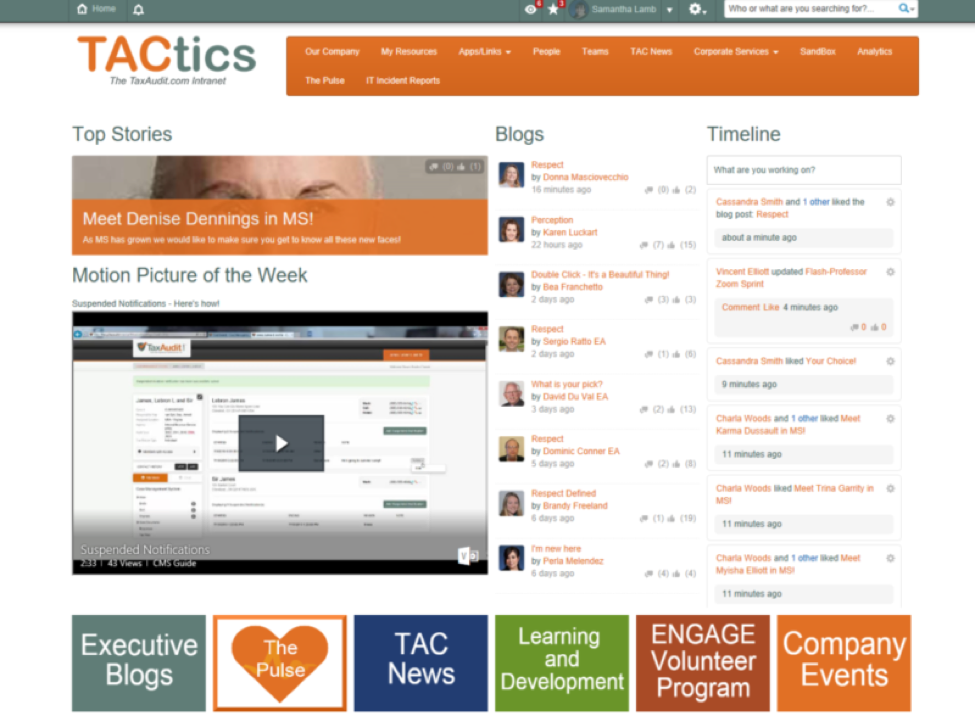
(TaxAudit.com, providers of tax services throughout the US, feature their blog feed on the homepage of their intranet, TACtics. Employees use the blogging tool to introduce themselves as new starters, to ask for advice or input, to share successes and to discuss challenges they face on a daily basis.)
3. Help employees get to know one another
I think more people are realizing this as a result of the “Silicon Valley” style of laid back offices and perks. But just in case you’re not on board yet, offices shouldn’t be stiff and lacking in fun. When employees bond and get to know one another, their ability to collaborate organically and productively will skyrocket. Helping them get to know one another can take the form of happy hours, team lunches, or whatever is the most exciting to you!
This is another place where blogs can be helpful. They aren’t only for employees to listen to the challenges of their team. Blogs help workers learn about one another and connect over shared interests, forming valuable communities.
Similarly, intranet tools such as Teams can bring together employees – particularly if they’re dispersed across multiple offices or locations. A People Directory that includes employee photos and profiles with personal as well as professional interests will also help your employees connect.
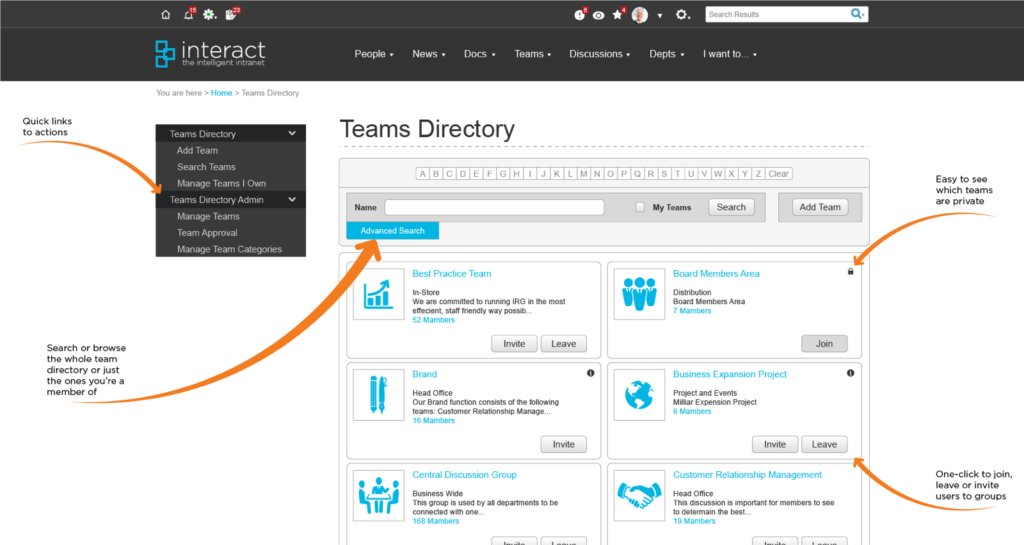
4. Clarify goals and responsibilities (then stick to them)
There’s nothing more disheartening than the feeling of floundering in confusion. Employees need to understand their company goals and how their work helps advance them.
Set specific goals for employees and put those goals in context to the wider business direction and objectives. Begin with your company values and mission, and cascade that direction down to individual KPIs or targets.
This should ideally be set between managers and their employees at the beginning of employment and then visited on monthly or quarterly bases to discuss whether they need to be adjusted.
When reviewing achievements or successes of employees, bring that back to the wider business goals once again, so employees are clear on their contribution. For example, ‘your work on project X helped us break into a new vertical, which was one of our core business objectives for 2017.’ This way, your employees are more engaged with their role and the business as a whole.
5. Encourage growth
No one wants to stay stagnant. If employees see their jobs as barriers to career growth, they’ll look for something new. If, however, they see you creating opportunities for them to learn new skills and move their careers forward, they’ll see this job as an asset that goes far beyond a paycheck to them.
Coaching and mentoring relationships are extremely helpful for anyone hoping to move their career forward. Set up this type of relationship with employees – helping them decide what goals to set outside the ones necessary to your team, imparting wisdom from your own career, and making sure they get access to the skill building tools they need.
6. Ask for ideas on your intranet, then listen
It’s that simple. Too many managers have a habit of soliciting ideas and only using the ones that were already in line with their views and strategy. Your employees have strong insights – they’re the ones on the front lines, doing the work that makes your department run day in and day out. When you ask for their opinions, take them to heart.
This is where collaboration and communication tools, such as intranet forums, can prove really powerful. Here, we see how a discussion forum can be used to ask employees for ideation on specific topics such as benefits, or for employees themselves to offer ideas and insight on various issues – whether that be the best places for lunch or onboarding practices.
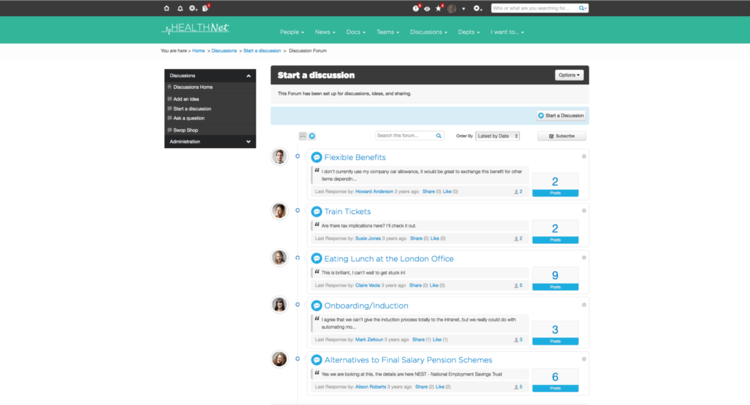
7. Do team activities that are just for fun
Want to host a potluck the week before Thanksgiving? Have a social night where you all go to a comedy show? Breaking up everyone’s busy schedules with a bit of fun for fun’s sake can go a long way. It’ll help them feel recharged and get to know one another, as well as associate fond memories with your office.
8. Measure as well as you can – your intranet can help
We all know that measuring engagement is notoriously difficult. But that shouldn’t stop you from trying.
Constructing a survey on your intranet of just a few questions can help you gather data on employees’ feelings, and that data can be transformed into action. You can also collect your data from blog and forum posts by your employees. It’s smart to also start your own forum threads, soliciting answers from them. This will help to give you infinite new employee engagement ideas.
The more you pay attention to the effect that your employee engagement initiatives are having on morale, the more skilled you’ll grow when it comes to achieving your goals.
9. Take Fridays to regroup
By Friday afternoon, everyone’s thoughts are drifting to the weekend, but that doesn’t have to mean 10% of the week is a total wash. Friday afternoons are a great opportunity to gather everyone together and talk about successes and challenges from the past week, as well as to set goals for the coming week. Not only will this give everyone a chance to relax and enjoy their work, it’ll ensure that everyone has concrete goals to work toward. It’s a win-win situation!
Here at Interact we try to make Friday’s special by ordering lunch for the whole office and by conducting weekly “Friday Chats”, in which a different person takes a turn each week presenting company news to all our global offices.

(Interact’s own Simon Dance, UK CEO (left), is joined by Customer Insights Manager Nigel Williams (right) to present the Friday Chat in our Manchester office. The video is streamed to all global offices and remote workers, ensuring inclusivity and a feeling of awareness amongst our employees.)
10. Focus on the “why”: CSR
It’s well known that many employees, Millennials in particular, care a great deal about whether or not their job contributes to the social good. If you build altruism into the DNA of your company and its messaging, you’re sure to inspire and engage workers.
One employee engagement idea for focusing on altruism is to create opportunities for the team to volunteer together for various causes, or perhaps arrange an office fundraiser or event. This is an incredible team building opportunity in addition to letting people do some good for the world.
As a non profit itself, Breast Cancer Now understands the value of articulating the ‘why’ in order to engage and inspire its staff. On their intranet featured below, we can see promotion of the London Marathon and future events on the homepage. This helps to promote and get employees involved with CSR activities.
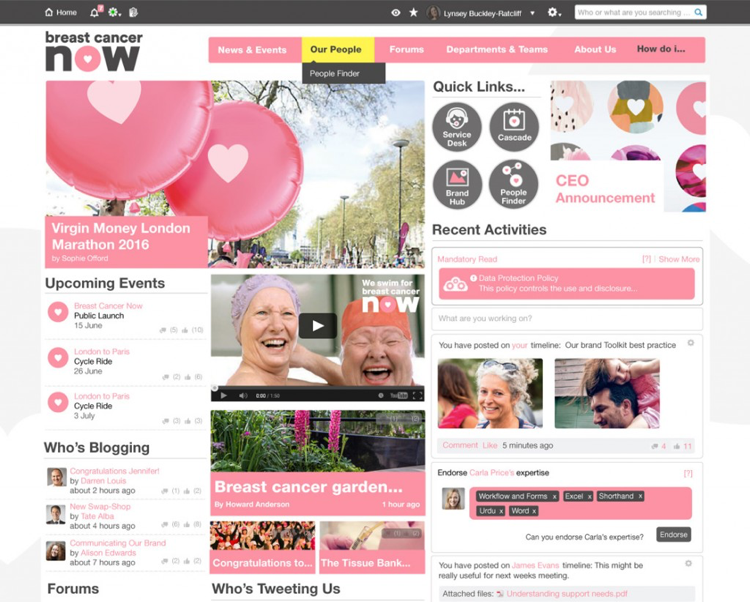
11. Respect work-life balance
Most people have rich lives outside of their day job. Whether this means traveling, taking photographs, or even just watching Netflix – those hours spent outside the office are important. Not only are they important to your employees, but they should be to you as well.
Without a real work-life balance, they won’t be able to recharge and be at 100% while they’re at work. Plus, a work environment that keeps people from the things they love breeds resentment and disengagement. Where possible, protect employees from the growing ‘always-on culture’ and establish clear boundaries between work and home.
This may take the form of guidelines on responding to emails and phone calls outside office hours, with managers leading by example. Work with employees to learn their commitments, taking care not to inadvertently cause them to miss those things which are important to them.
12. Start before day one with effective onboarding
First impressions last forever, and onboarding plays a huge role in engagement and performance down the line. However, onboarding doesn’t start on an employee’s first day – it starts earlier than that. It’s important that from the moment the decision is made to hire someone, they are included in team communications and that they feel as though they can have all their questions quickly answered.
Tailor and personalize your onboarding experience for new employees. For example, consider creating a dedicated intranet homepage just for new starters, which has an FAQ and a list of important people to contact with questions from different departments. You can also have quizzes that test employees’ knowledge on relevant topics after 90 days.
13. Build (two-way) trust
There are two kinds of trust you need on your team. Obviously, employees need to trust their manager as a leader. The other type of trust is trust that a manager has for their employees. When a manager trusts their team, they don’t micromanage and they give room for growth.
14. Reward, recognize, celebrate
Engaged employees are those who feel their work is recognized and appreciated. In fact, studies show that 69% of employees say they would work harder if they felt their efforts were better appreciated.
Make employee recognition a key principle for your engagement strategy. The positive results go far beyond employee engagement, as our blog on the value of employee recognition explores.
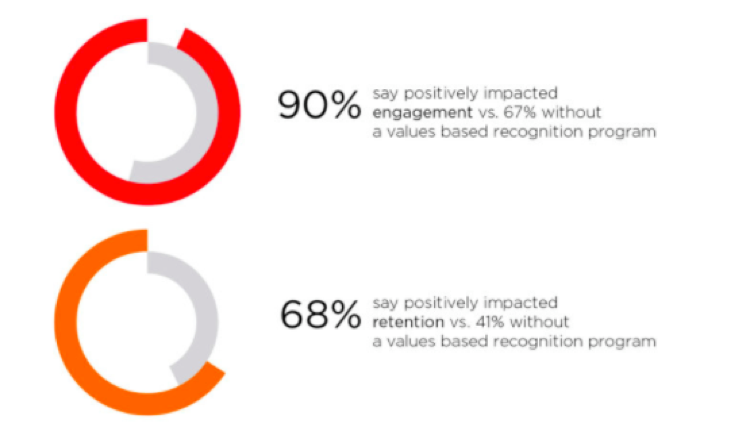
This may be as simple as coaching managers on the importance of giving ad hoc, in-time feedback, rather than waiting for structured performance reviews. Alternatively, consider using your company intranet for a peer-to-peer or manager-to-employee rewards program. Staff can give recognition for a job well done with a virtual currency, which could even be exchanged for tangible rewards further down the line – introducing gamification to the process.

Management blogs or simple social tools, such as the ability to ‘Like’, ‘Comment’ or ‘Share’ on your intranet also empower employees at every level to celebrate success, boosting engagement and morale.
15. Break down silos
It’s easy to get silo-ed into our own roles or departments, and lose sight of how others in our organization are doing. However, this closed way of working can prove detrimental to employee engagement levels.
Consider introducing a ‘buddying’ system or hot-desking for employees. This gives individuals insight into new areas of the business, which can promote innovation and ideation. Feedback or brainstorming sessions, utilizing individuals from different departments, provides a collaborative approach to engaging employees.
A change of scene and mixing different personalities is a seemingly simple process, but can have hugely positive results for igniting interest and engagement in your staff.
Employee Engagement in 2017
Employee engagement has been on the agenda for many years, but the numbers from Gallup should make you sit back and wonder what’s still going wrong.
Only 21% of employees say that their performance is managed in a way that motivates them to do outstanding work. It’s clear that low employee engagement is having an overwhelmingly negative effect on many other important business metrics. However, thanks to developments in technology and increased awareness, we now have the tools we need to make a change.
Taking only a few of the suggestions we put forth here as a starting point can take you far in your engagement. Consider how important this is to your business and start today by laying the groundwork for employees to be inspired to succeed!
Do you have any great ideas or tips for engaging your employees? Let us know below.
